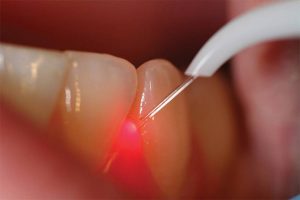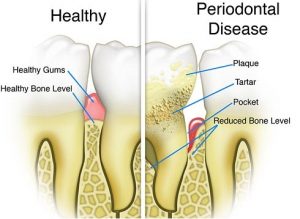What To Expect When Getting a Gum Graft: Before, During, and After

Have you noticed your gum tissue pulling away from your teeth, making them appear “longer”? This is called gingival recession and affects more people than you might imagine. When the gum tissue starts to recede, there is bone loss as well that exposes the root surface, which is more porous and softer than your enamel. As a result, many patients with gingival recession will experience sensitivity, abrasion, and/or decay. In very severe cases, the root surface can abrade so much around the neck of the tooth that the tooth is weakened to the point of fracture.
Gingival recession is often the result of thin gum tissue and if left untreated, can lead to one or more of the aforementioned negative effects. Thankfully, there is a periodontal surgery available to help restore the tissue in recessed areas. Gum grafting involves placing your own oral tissue, or special donor tissue, across the recessed areas. In doing so, the gum graft helps to protect the vulnerable root surfaces of the teeth by helping to prevent cavities, abrasion, and sensitivity. Often patients with root surface sensitivity have a difficult time finding products that work well enough to consistently reduce or eliminate the sensitivity, creating a daily battle that can be exhausting. Imagine being able to eliminate that sensitivity with just one periodontal surgery!
Preparing for Gum Graft Surgery
Prior to starting your gum graft surgery, a consultation with any one of our board-certified periodontists here at Laser Periodontics & Gum Surgery will be necessary. During your consultation visit, your treating doctor will perform a very thorough periodontal examination. Your chief complaint will be addressed, and you will be evaluated for various signs of periodontal disease, such as loose teeth and bone loss. X-rays will be consulted at this visit as well. We ask that you please provide a thorough medical history so that we can ensure you are healthy enough for periodontal surgery.
This is the Gum Graft
Local anesthesia is all that is needed to make you comfortable for your periodontal surgery. Once you are completely numb, one of our highly esteemed periodontists will begin the gum grafting surgery, which is typically a 60 to 90-minute procedure depending on the case. The tissue used to cover the exposed root surfaces can either be sourced from your own oral tissue or can be a special donor tissue. In the case that the tissue is your own, most often it is harvested from the palate of your mouth where the tissue is the thickest. This means that after the periodontal surgery, you will have stitches to care for in two areas of your mouth. In other cases, sometimes all that is needed is to simply move and reposition tissue that is adjacent to the exposed root surfaces. In cases such as these, donor sites are not needed and you will only have stitches in the site of the gum graft.
You Have Had Gum Surgery, Here is Your Aftercare Plan
After your gum grafting surgery, you will be at a much-reduced risk of developing sensitivity, root surface cavities, and abrasion! Following the surgery, it is essential to keep your head elevated and rest quietly for the remainder of the day. As mentioned earlier, following gum grafting surgery you may have stitches to care for in one to a few sites in your mouth. If donor tissue was taken from your palate, often you will receive a splint to wear over the palate to reduce swelling and help keep you comfortable.
Slight bleeding and oozing are to be expected, however, if the bleeding seems excessive apply firm pressure with a moist gauze or tea bag for about 40 minutes. Post-surgical pain can generally be well controlled with the prescribed pain medication. Be sure to take your medication as prescribed to aid the healing process.
Healing time is generally around two to three weeks. During this time, special care will need to be taken regarding diet and oral hygiene. Cool, soft foods are recommended, and it is best to avoid any food that is too hot, hard, or spicy that could aggravate the surgical sites. You may gradually begin to eat harder foods but avoid eating any sharp foods such as peanuts, nachos, tacos, etc.
Oral hygiene is encouraged to resume 24 hours after surgery, but care should be taken to avoid disturbing the newly grafted tissue. Swelling can be controlled by holding ice packs on the face outside the surgical sites, alternating between 20 minutes on and 20 minutes off the face. Additionally, you will be seen in the office to evaluate post-surgical healing. Should any severe pain, extreme swelling, or prolonged bleeding occur, please do not hesitate to contact our office!
Other Options for Periodontal Surgery

While gum grafting is excellent for covering exposed root surfaces that tend to make teeth appear very long, some patients have the opposite problem where teeth appear too short due to an excess of gum tissue. For cases such as these, a gingivectomy may be the perfect solution. A gingivectomy is done by simply removing excess or overgrown tissue around the teeth, and is often performed by using a sophisticated laser, which greatly reduces postoperative pain and healing time. A laser can also be used as part of the Laser Assisted New Attachment Procedure, or LANAP, to help remove harmful bacteria from deep pockets in patients with gum disease to promote periodontal health. To find out which periodontal surgery would best benefit you, please contact Laser Periodontics & Gum Surgery today by calling (877) 316-4330 to get your consult scheduled!


